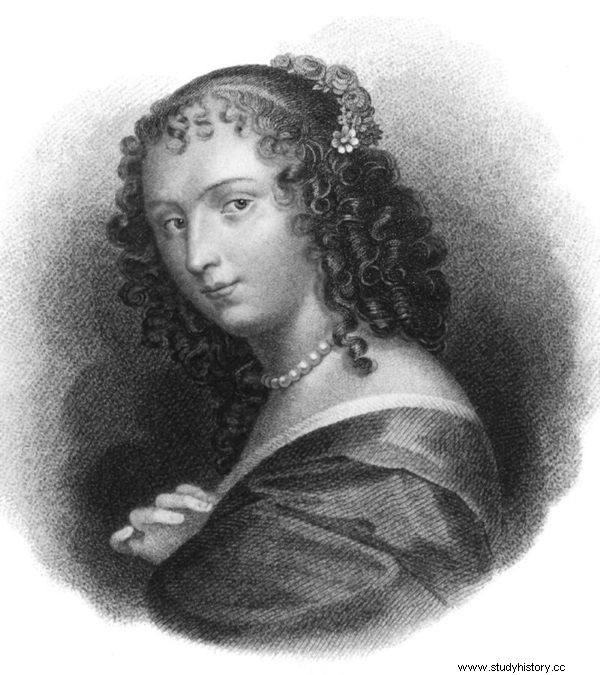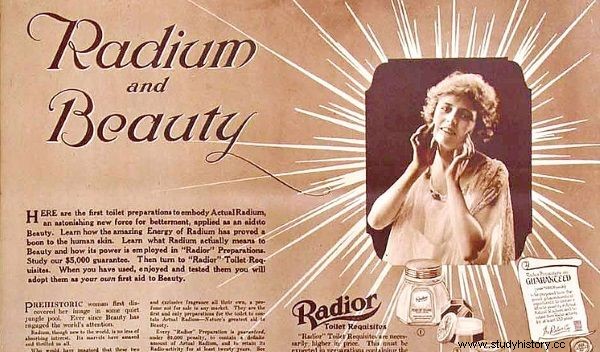Lead, arsenic, mercury ... This is not a list of poisons, but substances that were used by former beauties. Not only were they losing money, time and comfort, but also health and even life. What else were they ready to endure in pursuit of beauty and eternal youth?
The old saying goes that beauty requires sacrifice. But it doesn't say how big. Even today, the dream of a perfect complexion, shapely figure or young appearance often wins over common sense. And today's invasive treatments seem a breeze compared to what women have endured in the past. First of all, without being aware of it or simply not caring about it, they used a number of dangerous substances every day. What exactly were they poisoning?
Flawlessly lead complexion
Lead has a long and colorful - nomen omen - history in cosmetics. For example, it was part of the kohl, a type of black-out eyeliner that was used to give the eyes an almond shape. However, it was mainly used to whiten the skin.
Egyptians and Romans have already done it. To keep the face flawless, they applied a highly toxic lead white called cerusite or Venetian white. This is how it works in the book: "Facepaint. Make-up history ” Lisa Eldridge:
Thanks to the pure lead content, matting properties and a satin finish it gave, Venetian Cerousite has become the most coveted white primer. It was mainly favored by the European aristocracy, which could afford such an expense. The problem was that the more cerusite was used, the more it had to be applied to hide its unpleasant effects.
Long-term use caused skin discoloration, the complexion turned gray, tired, turned into shades of yellow, green and purple which finally made the face look like dried old fruit. The constant use of the drug was also the cause of tooth decay, bad breath and hair loss, and even permanent lung damage.

Ninon de L'Enclos. The cosmetic inspired by it was supposed to remove freckles. (photo:public domain)
Renaissance beauties, led by Queen Elizabeth I Tudor, were passionate about harmful cosmetics. In time, the leadhead began to take a deadly toll among them. And although the negative effects of the excessive liking to the use of lead-based cosmetics were visible to the naked eye, they were quickly sold on the masses.
In Victorian times, the market was flooded with products such as "Bloom of Ninon de L'Enclos", which allegedly removed freckles and scars, and made the skin of the face, neckline and hands extraordinary whiteness and smoothness. The famous preparation was named after the 17th-century courtesan Anna "Ninon" de L'Enclos and was said to have been made according to her recipe. It is said that Marie Antoinette herself used it with pleasure. The popularity of such products continued throughout the 19th century, especially among aristocrats and artists.
Arsenic baths
Another miracle product that "guaranteed" a perfectly smooth and fair complexion was ... arsenic. This extremely toxic chemical it was destroying red blood cells. It provided the desired pale skin, but it was fatal to use. Not everyone was aware of the threat, which Giulia Tofana used in the 17th century. She made a fortune selling a wonderful arsenic powder to the inhabitants of Palermo, Naples and Rome. The product was called "Aqua Tofana" and its author knew perfectly well that she was selling poison . She is credited with over 600 victims, including six husbands. Eventually, an Italian businesswoman was brought to trial and sentenced to death.
Arsenic-based products - this time to take - flooded the American market at the turn of the 20th century. Most often they were signed with the names of non-existent doctors, such as "Dr Rose's French Arsenic Complexion Wafers" or "Dr. McKenzie's Improved Harmless Arsenic Complexion Wafers ”. They were considered harmless. According to the producers, they were supposed to make the skin radiant, firm and smooth.
It quickly turned out that long-term use of arsenic has an impact on overall health. It caused damage to the nervous system and kidneys, hair loss, hemorrhages, blindness, a skin disease called arsenic keratosis, and vitiligo. The cost of the pursuit of beauty was high. In the American press, for example, you could read about a young lady from Indianapolis who was blinded by taking arsenic. In 1911, 18-year-old Hildegarde Walton of St. Louis died after taking a few boxes of the "miracle" product.
The use of arsenic for care purposes did not end there. Lola Montez, an actress and writer of the Victorian era, wrote in her book The Arts of Beauty about Czech women who regularly bathed in waters containing a high concentration of arsenic. Apparently "provided their skin with transparent white" . However, she warned that the price was high:"they must take a bath in arsenic springs until the end of their days, otherwise they will face imminent death."

John William Waterhouse's painting of Circe, often mistakenly thought of as Giulia Tofana's portrait (source:public domain).
With a slight mercury sheen
Mercury was already popular in Renaissance cosmetics. Before benzoyl peroxide was invented, it was used to eliminate blemishes and discoloration. Syphilis was also treated with her, hence the saying that one night with Venus can result in the rest of her life in Mercury's embrace. As if that were not enough, it was often used together with highly toxic antimony. This caused, among other things, irritability, mood swings, loss of hair and teeth, headaches, and insomnia.
Especially the eighteenth-century French women could not do without mercury. They put a thick layer of dye on their whitened faces. Mercury sulphide called cinnabar has been used as a pigment for centuries. Toxic mercury penetrated a thick layer of lead, penetrating the bloodstream and causing discoloration or peeling of the skin, which had to be covered with another layer of cosmetics.
A similar procedure was used by Italians, as the author of the book "Facepaint. Make-up history ” :
The Venetian beauties of this era, including the great lady of the fashion world, French Queen Catherine de Medici, also used a mixture of mercury (a reliable ingredient to lighten discoloration and freckles) and arsenic with a hint of musk . Ironically, musk and its components can cause hypopigmentation, proving once again that the more money someone had for cosmetics, the worse they could look.

Katarzyna Medycejska had an unparalleled political intuition. In the case of a passion for whitewash, her instincts had clearly failed her. (photo:public domain).
The price was high, but it did not offend the beauties of the time. After all, the light shine of mercury-based cosmetics gave them the desired effect of youth, innocence and radiant skin.
Radium mask for a radiant complexion
New "temptations" for lovers of beauty appeared with the discovery of radium in 1898 by Maria and Pierre Curie. Enterprising traders soon proposed completely new uses for the radioactive elements. “In the radium energy there is a gushing fountain of youth and beauty!” - the advertisement of Radior cosmetics from 1918 promised.
In the 1930s, the Tho-Radio brand was established in France, the name of which was derived from two radioactive compounds:thorium chloride and radium bromide. The manufacturer promised women firm skin, a slim figure, removing all imperfections, stopping the signs of aging, and a fresh and young complexion. More cosmetics of this type appeared:in the 1920s, for example, radioactive clays in the form of masks were popular. They were sold under the aegis of the Kemolite brand, among others.

In the 1920s and 1930s, products based on radioactive elements were an absolute must-have. They covered the whole range of cosmetics, from creams to toothpaste. Interestingly, the active substances could even be found in baby products, chocolate, condoms and cigarettes . Only later studies proved that the "radiant" complexion was sometimes costly with vomiting, anemia, internal hemorrhages and cancer.
Smooth skin requires suffering
Women also put themselves in danger by trying to find a way to get rid of unwanted hair quickly and easily. They used… thallium for this. This highly toxic and poisonous element, discovered in 1861, was initially considered a perfect remedy for venereal diseases, mycosis, dysentery and tuberculosis. The idea of using it for depilation arose when it was noticed that an agent, prescribed for mycosis of the scalp, causes hair loss.
The cream was launched on the American market by the Koremlu brand. Already in the 1930s, a scandal broke out in connection with the harmful effects of the drug. Unfortunately, the product was not classified as a drug by the Food and Drug Administration at the time, so there was nothing the government could do.
During this period, more shocking incidents hit the headlines. One child died after eating bread smeared with a killer product. Civil lawsuits multiplied against the producer. To no avail - he "saved himself" by declaring bankruptcy. Ultimately, entrepreneurs who expected a quick and easy profit had to accept that the use of thallium had to be limited to rat poison . Or use it as a murder weapon, like the murderer in Agatha Christie's mystery story "The Mystery of the Pale Horse" .

Radior was a popular preparation that was supposed to add "radioactive shine." Advertising from 1918. (photo:public domain).
The women, however, had a choice of another, no less dangerous method of hair removal. They were offered treatments of this type, as well as treatment of eczema and acne with ... X-rays discovered at the beginning of the 20th century.
Some desperate ladies managed to expose themselves for hours. Yes, the hair fell out, but as a bonus there were cracked capillaries, blisters on the skin and thickenings. The latter often turned into neoplasms, incurable at that time. After a series of claims for damages, this lucrative business also lost its popularity.
In pursuit of beauty
Are today's trends in cosmetics so different from what was in force fifty, one hundred or three hundred years ago? Today, when advertisements bombard us with images of models with perfect silhouettes, perfectly young and smooth skin and shiny hair, it seems that they are not. In pursuit of the ideal, women today inject themselves into their skin with neurotoxins. They also patiently undergo painful treatments with the use of laser rays, which are to lighten their complexion, remove wrinkles or unnecessary hair.
They apply many cosmetics to the skin or hair, often carcinogenic and highly poisonous, such as formaldehyde present in body or nail care products. Despite many years of fighting to eliminate heavy metals from cosmetic products, they are still present. Lead can be found in lipsticks of popular brands, and mercury in mascara, for example. Should we believe the producers that they are safe anyway?
Literature:
- Rajiv Shah, Kelly E. Taylor, Concealing Danger:How the Regulation of Cosmetics in the United States Puts Consumers at Risk , "Fordham Environmental Law Review, Vol. 23, No. 1/2011.
- Aleksandra Zaprutko-Janicka, Beauty without preservatives , Horizon 2016 sign.
- Agnieszka Bukowczan-Rzeszut, Barbara Faron, Seven deaths. How died in the olden ages , Astra 2017.
- Eldridge, Facepaint. Make-up history , crowd. B. Zandman, Znak Horyzont 2017.
- Lola Montez, The Arts of Beauty; Or, Secrets of a Lady’s Toilet , Dick &Fitzgerald 1858.
